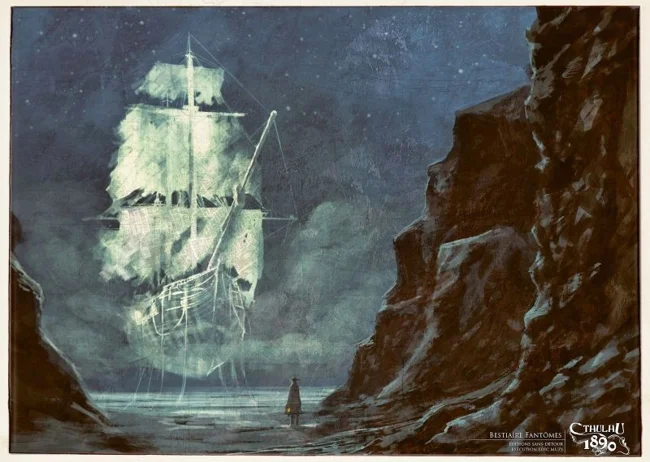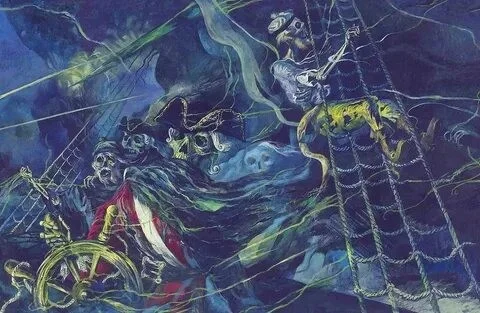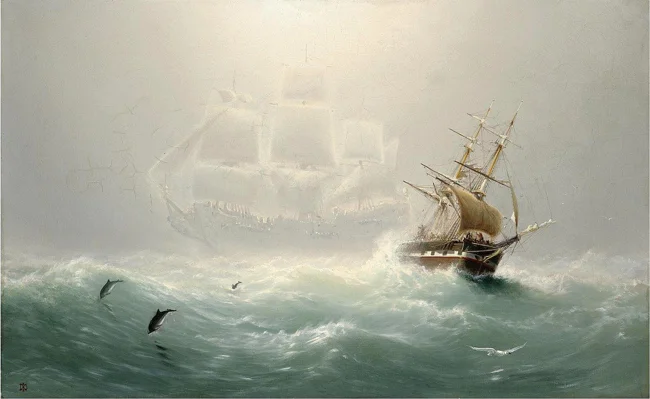The Legend of the Flying Dutchman: How a ghost ship became a symbol of maritime mysticism (6 photos)
Many consider this a myth. But what if the legend was born not out of thin air, but from pain, fear, and real disasters that sailors for centuries could not explain? 
On the docks of Europe, where the air smelled of sea, tar, and cheap wine, sailors sat in taverns, clutching mugs of rum to their chests, and told stories. Of gold, of storms, of monsters. But the most terrifying of all—of a ship that couldn't dock. Of the Flying Dutchman. Of a captain cursed for hubris and murder. About a ship that sails through the centuries, restless. 
The Tragedy That Began a Myth
In 1641, off the Cape of Good Hope, a drama unfolded that became the basis for one of the most enduring maritime legends. Captain Philip van der Decken, a man with a reputation for cruelty and blasphemy, was returning from the East Indies. A couple was on board. He fell in love with the woman, killed her husband, and offered her his hand. In despair, she threw herself overboard.
A storm that broke soon after only fueled his rage. The crew demands shelter in the bay. He refuses, swearing that no one will go ashore. At that moment, according to legend, a voice from the heavens calls out, "So be it!"
From then on, his ship was doomed to wander the seas forever. The crew were dead. The captain himself was half skeleton, but still capable of command. Meeting him was a bad omen. Death awaited those who saw him. The story became a maritime warning: pride and cruelty are the path to eternal wandering. 
From Anecdote to Print
For a long time, the legend existed only in oral form. The name "Flying Dutchman" first appeared in 1790, in the memoirs of the English explorer John MacDonald. He wrote how the crew of the ship he was sailing on saw a strange sailing vessel on the horizon. A vessel that had perished at the Cape of Good Hope, but was forever returning in storms.
From that moment on, the legend began to spread.
In 1804, the poet Thomas Moore mentioned a ship sailing in a dead calm in a poem.
In 1813, Walter Scott called it a "pirate ship" in his poem "Rokeby"—at that time, the legend had not yet been canonized.
But the turning point came in 1821, when Blackwood's Edinburgh Magazine published a text that for the first time brought together all the elements of the myth:
— murder,
— a curse from heaven,
— eternal voyage,
— and the name Van der Decken.
From that moment on, the legend took on canonical form. All subsequent interpretations—from operas to films—were based on this text. 
The Real Man Behind the Legend
Interestingly, the villainous Van der Decken had a real-life counterpart. In the 1660s and 1670s, Captain Bernard Fokke, who served in the Dutch East India Company, gained fame. He became famous for sailing from Amsterdam to Java in 3.5 months, while others needed 5. His ship carried mail—and his speed was documented.
His detractors whispered, "He sold his soul to the devil." Fokke only laughed, but his reputation as a swift, almost supernatural sailor stuck with him. Decades later, the name Fokke (Flying Fokke) was transformed into "The Flying Dutchman," and his image became that of a cruel, cursed captain.
Thus, naval glory became a mystical legend. 
Wagner and the Opera That Cemented the Myth
In 1839, Richard Wagner, sailing to England, encountered a violent storm. During the storm, he recalled Heinrich Heine's novella featuring "The Flying Dutchman." Arriving in London, he sketched out a libretto. It was later purchased by a Parisian theater, and the opera "The Ghost Ship" was written based on it by composer Pierre-Louis Dietsch.
But Wagner did not let go of the legend. In 1843, he wrote his own opera, "The Flying Dutchman," the most famous artistic rendering of the myth. The ending is unexpectedly bright: the captain is forgiven when the Norwegian sailor's daughter sacrifices herself, promising to be his faithful wife. Both die, but their souls are saved.
For Wagner, this is a happy ending.
Although, of course, on his scale, death in love is salvation.
The King Who Saw a Ghost
The sails disappeared, replaced by steam engines and iron hulls. But encounters with the "Flying Dutchman" did not cease.
One of the most unexpected witnesses was the future King George V of Great Britain.
In 1881, at the age of 16, he was traveling with his brother, Prince Albert Victor.
On July 11, he wrote in his diary:
"At 4 a.m., the Flying Dutchman passed directly in front of us, 200 yards away. The ghostly ship glowed with scarlet lights, illuminating its masts, rigging, and sails... Thirteen people saw it, but when we tried to get closer, no one saw any trace of the large ship passing..."
A strange episode. Mysticism? A mirage? Group psychosis? But 13 witnesses are not the sum of one delirious individual.
This had no effect on the fate of the heir to the throne. He became king.
And the legend lives on. 
What was behind the "ghosts"?
In fact, "ghost ships" were not uncommon. Epidemics broke out in the tropics—plague, typhus, smallpox. Everyone on board died. A ship, caught by the wind, would continue to float for months. These floating morgues were found with tattered sails, rats, and notes. They were mistaken for ghosts.
And sometimes they were mirages. Optical illusions in the tropics created the silhouettes of ships that weren't there. But everyone saw them—so they weren't hallucinations.
What do you think it was? A mirage? A floating corpse? Or just a story we tell to avoid fearing the ocean's emptiness?
Do you believe that someone can wander the seas forever for their sins?
Or is "The Flying Dutchman" a metaphor for human pride that cannot find peace?

























